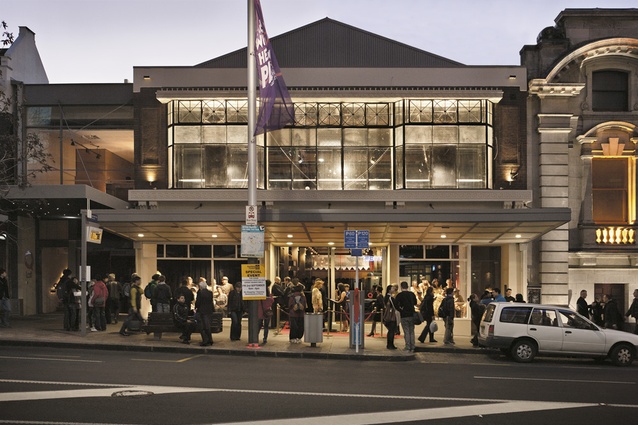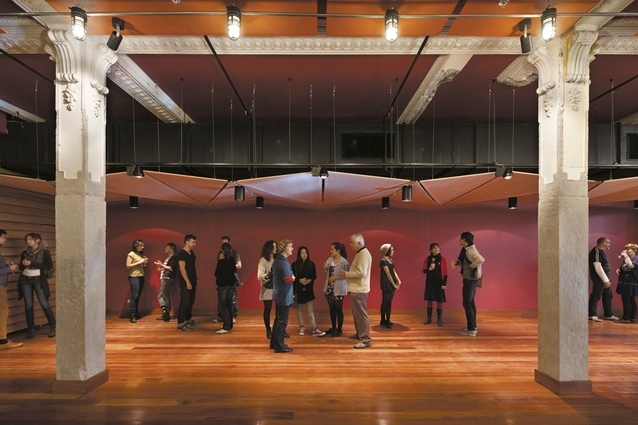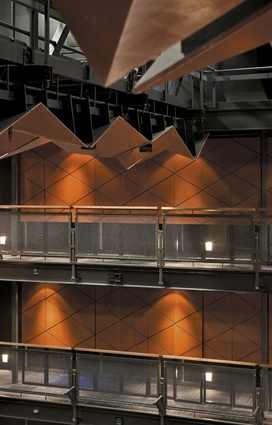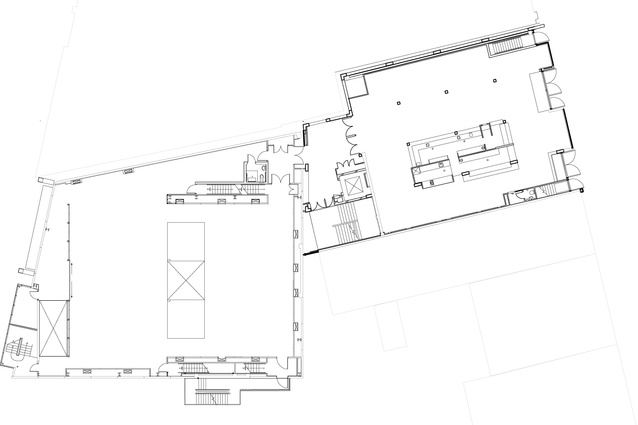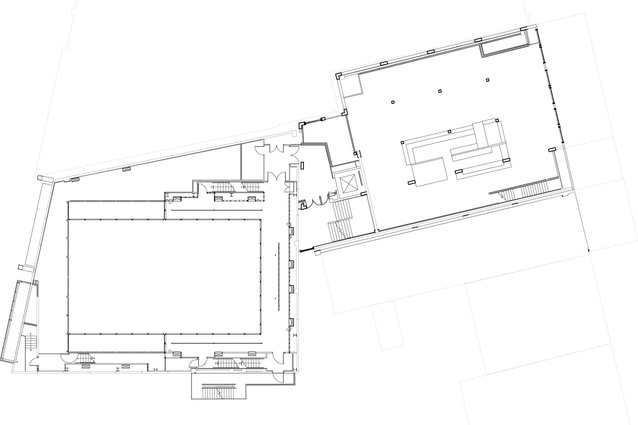Q Theatre – Auckland’s civic gem
Cheshire Architects and William Ross Architects introduce the smell of grease paint and the buzz of appreciative audiences to a tight Queen Street site.
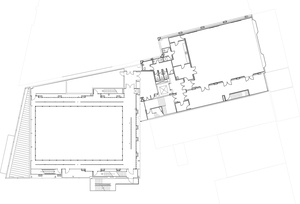
There’s a lot happening in our brand new supercity. It’s not surprising that Auckland’s focus has been on the waterfront lately, what with the Rugby World Cup “Party Central” wild goose chase and the debacle of the Queen’s Wharf competition. The good news has been the fab new North Wharf development in Wynyard Quarter, showing perhaps what can be achieved when politicians stay out of it and let designers run the show. But, meanwhile, in our Civic Precinct, that dead centre of the city, Aotea Square has reopened without much fanfare and is still looking pretty bloody ordinary. That grande dame of late modernism and centrepiece of our arts precinct, the Aotea Centre, despite a facelift that has planted a cafe on its steps, remains a lifeless iceberg, remote and frosty as ever. The football-field-sized “square” has lost the Terry Stringer sculpture that stood there for years. I wasn’t a great fan of it but, like a submarine conning tower breaking through a bleak, polar plain, it did add, as they say, visual interest to the bland expanse of plaza. Selwyn Muru’s marvelous carved and painted waharoa is still there, richly embellished and vigorous, one of the few signs around here that we are actually at the southern tip of Polynesia, not in bloody Finland.
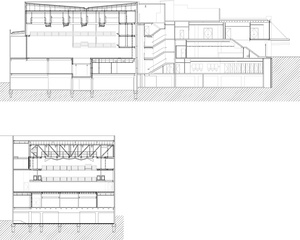
In stark contrast to this still-to-be-resuscitated modernist precinct is an intricate and urbane new addition to the area: Q, a little performing arts complex next to the Town Hall. From Queen Street, it is so integrated with the existing between-the-wars shopfronts that you may actually overlook it – hopefully it will be less coy and sprout a few signs soon. The cafe and bar crowd are gathering, however, even before the curtain’s gone up on the place and anyway, from Mayoral Drive and Greys Avenue, where you’ll be parking your car, the collision of big multifaceted cubes is unmissable.
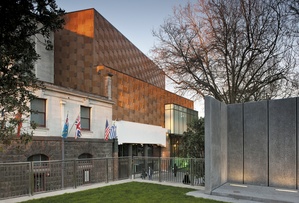
Q has arisen from the same need for a flexible four-hundred-seat theatre that the temporary Watershed Theatre down on the waterfront addressed. For a decade, the trust has been looking all over town for a site, with architect Pip Cheshire involved all that time. This location is the right one, near the Aotea Centre, the Civic, the Town Hall and the Classic. It will contribute to a performing arts heart in the centre of town. It is a tricky site though: a steep wedge south of the town hall, near where Mayoral Drive and Myers Park cut a hole in Queen Street. The architect has made the right decision to place the entrance and main space level with Queen Street. Here it invigorates our main street, whereas lower down off Greys Avenue it would be compromised by the tunnel entrance to the Civic Car Park. I like the directness of connection between street, foyer and main space, with patrons spilling out onto the footpath in the same way the Town Hall does. In contrast the Aotea Centre can swallow thousands and you won’t even know something’s on.
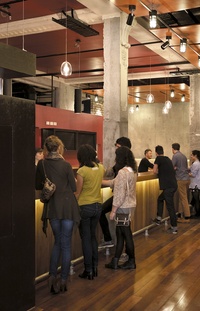
Off Queen Street the space is split by a bar and ticket sales into two areas, one a more intimate cafe and bar, the other a foyer and lounge where you can also sit and drink. And if Q stands for queue rather than Queen, then at least that line of waiting folk will parallel that bar. Q’s main space will seat up to 450 in a big black-box-type theatre. The three levels of seating are in movable banks that can shift to create a variety of types of venue: from stage through long and short traverse to theatre in the round. The two rows of gallery seating above are wheelchair accessible and can also move up and down on gantries. The venue is yet to be tested but seems a good size, flexible and well equipped with fly areas and a lift that can hoist a car on to the stage, for instance. On the first-floor level of the Queen Street building (originally the No Deposit Piano Company) there is a smaller performance space called the Loft that can seat 120. With its own entrance off Queen Street, backstage facilities and toilets, it can operate independently or as part of the complex.
Where the old Piano Company building ends, in the centre of the site, Cheshire Architects and William Ross Architects have inserted the major circulation core: lift and stairs. The architects have also twisted the grid to shift away from the main street toward Greys Avenue which runs behind the Town Hall at an angle, creating a triangular block. This also splits the building, allowing southern light to penetrate into the core and a side entrance mainly for staff. But that stairway is grand and inviting enough to function as a public entrance from the car park too.
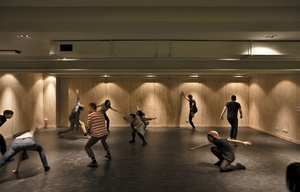
Within the new building, beneath the footprint of the main space, are offices, rehearsal spaces, read-through rooms and a cart dock. The rehearsal space, aka the Vault, can also be independently accessed as a performance space for more fringe stuff. The big colliding cubes that make up this building are very visible from Aotea Square and Mayoral Drive – they let you know there is something new on the block. It’s all in the heritage shadow of the Town Hall, and is respectful in terms of scale, bulk and height; but being at the south end of the block, it is also in literal shadow a lot of the time and next to a banal sea of asphalt car park stuffed with council vehicles. Precast concrete is, of course, the answer to acoustic issues here, but the colour and intricacy of the faceted finish mean this place glows warmly in the evening sun and, like a highly embellished casket, intimates rich content, an inner world and the intimacy of theatre. One disappointment is the low facade of the old Council Garage. I’m all for retaining it but its charming portal sets up expectations of an entrance to a lovely little space that are disappointed. But this is the kind of complex that has all its bones in the right place and one can imagine in future years (and with future budgets) this could easily be rectified.
Speaking of money, I am surprised at how much has been accomplished here. As I understand the issues, it has been pretty much a public and professional initiative that has given us this new little civic gem. The whole place is a bit raw on the inside but I don’t mind it looking a bit make-do because it helps the make-believe you have really come here for. Theatrical spaces get bashed around, they are quite rough and ready, but it’s a world where greasepaint, cardboard and that guy you recognise in the supermarket are metamorphosed by darkness, light and performance into that magic transcendence of the theatrical over the mundane. This is a lovely intricate and urbane complex knitted well into the fabric of the city. But it is only a stage after all, only the start of some magic experiences to come in this space.

